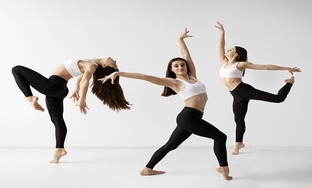
In the dimly lit wings of the stage, the dancer stands alone, poised to make a grand entrance. As the hum of the audience gets louder, the dancer’s heart flutters – a mix of nervousness and anticipation, not exactly performance anxiety, but the determination to perform flawlessly in their mind. Be it seasoned dancers or beginners, everyone gets a bit nervous before a performance. However, as soon as the music starts, the dancer gets into the rhythm and everything falls into place – the grace, panache, exuberance even. This magical transformation is because of the role of motor memory in dance.
Karthik Manikandan, a classical dancer, and cine artist from Bengaluru calls it the ‘brain’s magic’ as it allows you to dance without losing track of choreography despite last-minute stress.
“Most dancers do not think about how the choreographies are stored in the brain or how it works,” says Manikandan. “There is a scientific side to it. We do practice as much as we can before a stage performance, and it is the ‘brain’s magic’ to store everything and reflect it on stage.”
Dr Shubha Subramanian, a consultant neurologist from Chennai, explains this in scientific terms. ‘Brain’s magic’ in dance is motor memory in action. It is the reason for learning and recall of motor skills and procedures.
What is motor memory?
The memory involved in learning and using motor abilities including coordination and control of muscles and physical movements, is referred to as motor memory. It includes the memory of precise actions, movements and sequences needed to successfully complete a given motor task.
“Even though the act is being performed by the muscle, the control is still based in the central nervous system,” says Dr Subramanian. “When performing regular activities like driving or typing, we do not constantly activate our motor cortex [part of the brain that helps control voluntary movements in the body] and concentrate on the task at hand. Still, we complete the task without any difficulties. This is motor memory, and we can make use of it when dancing.”
Motor memory is formed through repeated practice and strengthening of neural connections between the brain and muscles.
Role of motor memory in dance
Dancing involves repeated movements and sequences. Through regular practice and repetition, dancers develop motor memory enabling them to recall the movements and carry them out naturally without consciously thinking about each step.
“Motor memory develops with practice. As you keep practicing and repeating the same movements again and again, it gets stored in the brain,” says Dr Subramanian. Several regions in the brain make a coordinated effort to perform a specific movement. By repetition, the movements are stored in the motor cortex, the basal ganglia (a group of interconnected structures in the brain responsible for motor control, learning, and reward processing) initiate the movement and the cerebellum (region of the brain responsible for coordinating movement, maintaining balance, and enabling precise motor control) adapts to the movements.”
Breaking up choreography into smaller pieces and practicing it over a long period of time can aid in effective development of motor memory.
“For instance, it is easy to forget a 45-minute long dance sequence learnt all at once,” says Dr Subramanian. Building up motor memory is easier by learning it in bite-sized pieces. After some practice, you will not need to focus on each step during the 45-minute performance. Once you start, you will continue it because it is already ingrained in your memory.”
Kinesthetic sense in dancing
The ability to sense and regulate one’s body movements and positions in space is referred to as kinesthetic sense in dancing. By enabling the body to recall and replicate movement patterns, motor memory supports kinesthetic sense in dance. This memory allows dancers to enhance their kinesthetic sense by being more aware of their bodies, spatial orientation and coordination.
“Kinesthetic sense is essential in dance forms that include props. Especially in Indian dance styles like Kuchipudi, where dancers balance on a plate and Karakattam, where dancers balance a pot on their heads,” says Dr Subramanian. “Kinesthetic sense needs a conscious effort in the beginning but once you learn and develop reflexes, it happens automatically.”
Through consistent practice, motor memory helps dancers in many ways, ultimately leading to a sense of confidence in dancers. This self-assurance enables dancers to concentrate more on artistic expression and audience engagement, resulting in more captivating and powerful performances.
Takeaways
- Motor memory is the brain’s capacity to retain and recall previously learned movements and abilities for effective execution without conscious effort.
- Dancers acquire motor memory through continuous practice and repetition, which enables them to retain the motions and execute them naturally without conscious effort.
- Motor memory improves kinesthetic sense in dance by enabling the body to recall and recreate movement patterns.
















